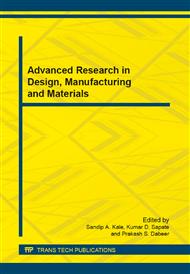p.89
p.97
p.105
p.111
p.117
p.123
p.131
p.139
p.145
Analysis of Failure in Adhesively Bonded Joints Using Traction Separation Theory
Abstract:
In recent years, there has been a tremendous increase in the use of adhesively bonded joints for the structural components as they offer various advantages such as low structural weight, low fabrication cost, and improved damage tolerance. One of the major concerns in their use is the crack produced at the interface of adhesive and adherend surface causing the failure of the joint. A study on the determination of crack growth can contribute momentously to avoid the joint failure. In this study the crack growth caused in adhesive due to displacement controlled loading has been analyzed by ABAQUS/Explicit software. Crack growth was modeled in the double cantilever beam (DCB) using traction separation law by element-based cohesive behavior. The analysis showed that: (1) The adhesive joint behaves linearly before the first cohesive element failure and after that the failure continues to increase even on decreasing the load untill it fails completely, (2) The noise during the failure of adhesive is caused due to the stress wave which is produced as a result of sudden loss in traction between the adhesive and the adherend.
Info:
Periodical:
Pages:
117-122
Citation:
Online since:
August 2014
Authors:
Keywords:
Price:
Сopyright:
© 2014 Trans Tech Publications Ltd. All Rights Reserved
Share:
Citation:


